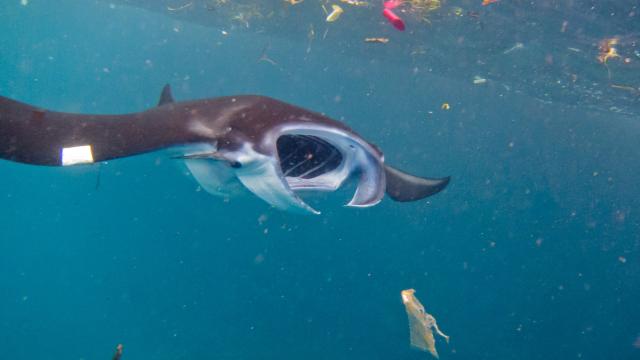Manta rays and whale sharks are among the largest filter-feeding fishes on the planet. To power their bulk, they sieve massive quantities of plankton out of the water. But new research off the coast of Indonesia suggests their meals come with an unwanted garnish: an alarming amount of plastic waste.
The waters around Indonesia are rich with plankton and provide ample feeding opportunities for mantas and whale sharks. Unfortunately, these same feeding grounds are also where our trash tends to accumulate: Indonesia is the world’s second-largest marine plastic polluter, and waves and currents concentrate much of that material nearshore.
Having spent much time diving in Indonesia and seeing the sheer magnitude of plastic waste nearshore, Elitza Germanov, a marine biologist at the Marine Megafauna Foundation and Murdoch University, wondered how much of the junk was getting funneled into manta and whale shark gullets. Previous research showed that whale sharks can swallow plastic pieces when feeding, but scientists hadn’t observed the same issue in mantas.
[referenced url=” thumb=” title=” excerpt=”]
To find out, Germanov and her team collected and counted plastic waste fragments in the water above reefs across Indonesia. The researchers targeted areas where the mantas and whale sharks were known to commonly feed, dragging a fine-meshed plankton net through the water from the boat. Then, they took the samples back to the lab.
“We separate the plankton and other natural material from the plastic using gravity and sea water,” Germanov told Earther in an email. “Basically, plankton sinks and plastic floats.”
After counting and categorising the plastic, the researchers could use the plastic count and the volume of water sampled to get the density of plastics in the water. Since the team knew about how much water mantas and whale sharks filter while feeding, they could make predictions about how much plastic the animals might be swallowing.
Spoiler alert: it’s a lot.
The team’s results published on Tuesday in Frontiers in Marine Science suggest that in some parts of Indonesia, mantas could be chowing down as many as 63 pieces of plastic per hour. For whale sharks in East Java, where the giants seasonally congregate to feed, the rate could be as high as 137 pieces per hour.
Of course, those are estimations. But Germanov and her team received first-time, concrete confirmation that manta rays are ingesting the stuff. They managed to get their hands on some fresh manta vomit and poop. Both of which contained many fragments of plastic. For the manta poop, it was 26 pieces while the researchers found an average of 66 pieces in the vomit.
And yes, collecting manta poop and puke involves a significant amount of luck.
“We enlisted the help of the local SCUBA diving communities who visit the manta ray aggregation sites regularly and asked them to carry “˜poo tubes’ in their [dive gear] pockets while diving just in case they saw the manta rays egest poo or vomit,” Germanov said.
The apparent routine consumption of plastic at these feeding sites is alarming, since plastics have the ability to deal serious damage to whale sharks and mantas alike. Things like plastic drinking straws can harden in the stomach of whale sharks, becoming fatally sharp lances when they jab into the stomach lining.
“There are already several examples of plastic being found in the digestive tracts of stranded and deceased whale sharks in Brazil, Thailand, Philippines and Malaysia,” Germanov said.
Filter-feeders are particularly vulnerable to concentrating vast quantities of plastic fragments in their bodies given the way they feed. The scope of the problem may even extend to the long-term survival of the the mantas and whale sharks.
“In other organisms, including fish, we know that exposure to some of the plastic associated pollutants can disrupt the regular functioning of the endocrine system, the system responsible for controlling growth and reproduction,” warns Germanov. “As threatened species, neither manta rays nor whale sharks can afford to have any dips in reproductive rates.”
Phthalates”additives in plastic that make it more flexible”are behind some of the reproductive chaos Germanov describes, and their impacts extend well beyond Indonesia’s waters as well. They’ve been showing up in the muscle of basking sharks and fin whale blubber in the Mediterranean, and even in the skin of whale sharks in the Gulf of Mexico.
For all the dire news, the study also reveals some information that might help in tackling this particular plastic pollution problem. The researchers found that plastic abundance increased by more than 40-fold in some places during the rainy season as deluges over Indonesia washed plastics out to sea. Concentrating plastic cleanup efforts on riverbeds and waterways right before the start of the wet season could be a good strategy to reduce the amount that ends up in the ocean, Germanov said.
The study also found that most of the plastic waste nearshore was fragments of single-use shopping bags and food wrappers, so reducing the use of those materials could also help, she said. The Indonesian island of Bali took a major step in this direction earlier this year, banning single-use plastics.
The saturation of once-pristine reefs with plastic waste isn’t exactly easy to watch, but Germanov plans to keep pursuing research that shines a light on the pollution problem as well as potential solutions.
“Seeing plastic amidst feeding manta rays, and in general in the water, is never something I can get used to,” she said. “Initially I would get quite emotional about it, and I still do on the “˜big days’”when there is more plastic than average, but now I turn my focus on getting the documentation of the issue and ensuring the science is completed correctly.”
